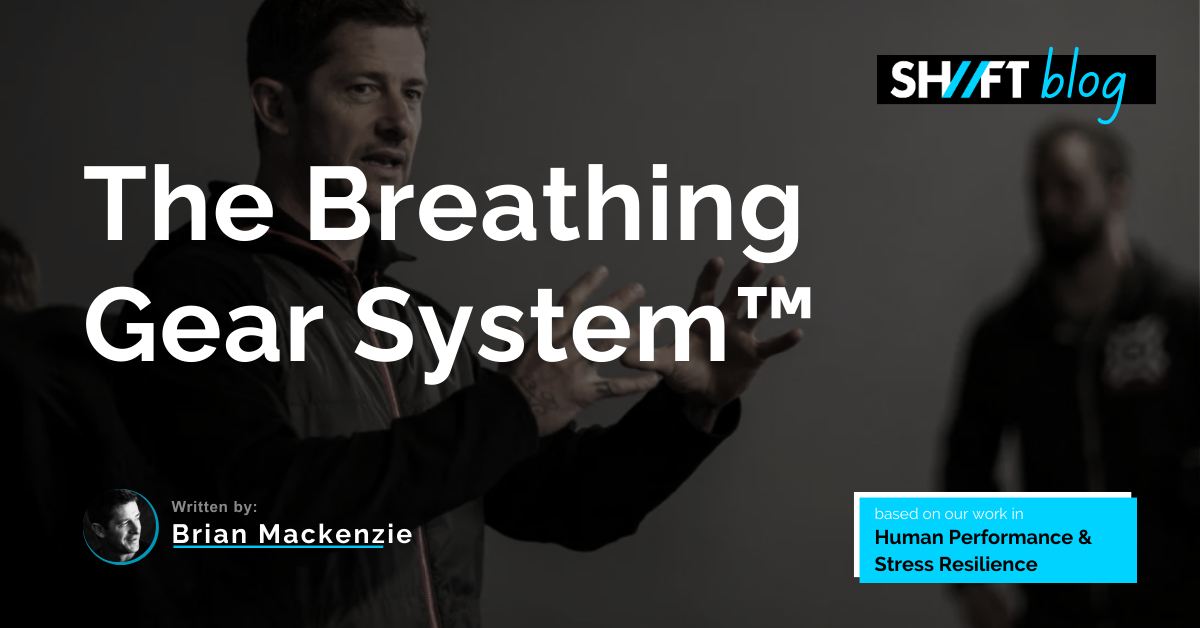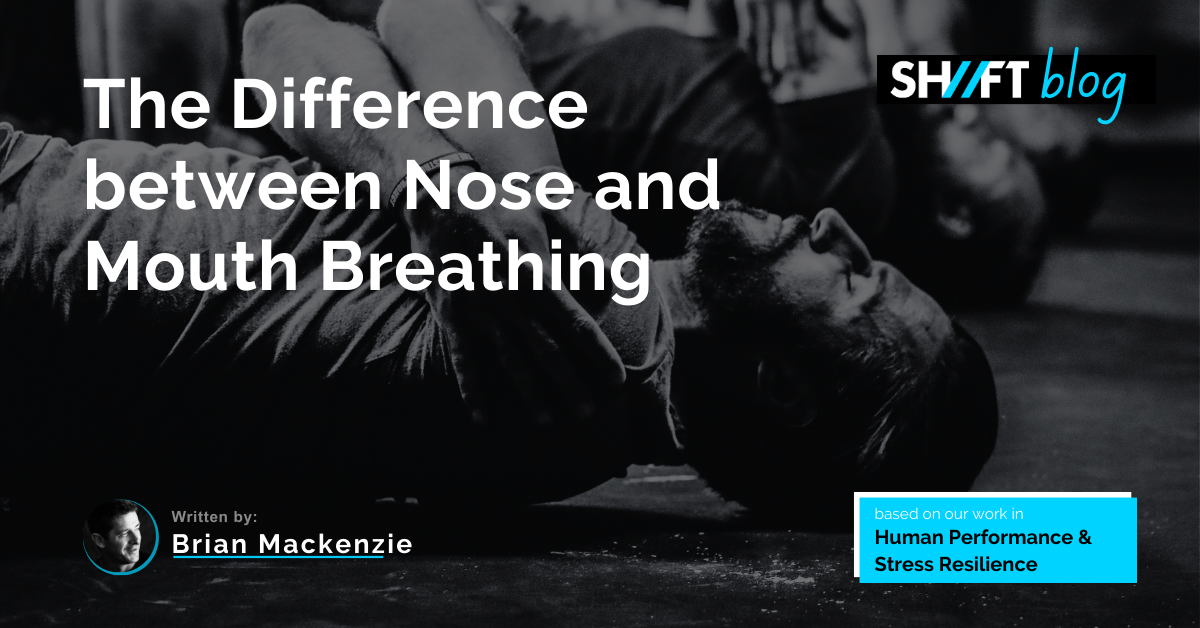When we think about the respiratory muscles, it is easy to overlook the complexity and nuance of their training. SH//FT’s Breathing Gear System was developed to encourage people to consider the training of our primary respiratory muscles through learning more about differential control of respiration rate (RR) and Tidal Volume/depth (VT), which is the volume of air moved in and outside the lungs in each breath cycle.
However, research (A, B, C) and experience show there is much more at play than we understand about metabolic acidosis regarding nonlinear increases in Ventilation (V̇e) above compensatory thresholds– Respiratory Compensation rate (RCP). If we were to take an unfit and a very fit person and have them start running they would have very different ventilation rates and depths as acidosis would impact them at varying times at the exact same intensities. VT1 (ventilatory threshold 1) a marker we use to mark a significant change in metabolism, namely a rise in lactate. Coincidentally, as lactate rises so will carbon dioxide levels, and a number of other processes.
In addition, there is a complex relationship between primary and secondary respiratory muscles and the metaboreflex (blood stealing) for regulating ventilation during exercise and bouts of intense stress.
Training the Respiratory System
The diaphragm and the external intercostals are the two (larger) primary muscles involved in breathing. Together, these muscles work in a coordinated manner to maintain proper ventilation during rest and exercise. Contrary to famous speak (even by professionals), these muscles always work; to what degree and how weak they are is a different story, but not one of abstinence.
Control of Respiratory Rate (RR) and Tidal Volume (VT) are two critical aspects of respiration that can be trained with The Breathing Gear System™. By controlling RR and VT independently in suitable environments, you can prepare your body to regulate your breathing more efficiently under most stress or physical activity.
Many practitioners (myself included) have used resistance breathing devices and technologies to separate actual human movement from ventilation/breathing. In most testing scenarios, my experience and testing have shown otherwise in keeping breathing assessments connected to human movement and with varying intensities and strategies that our anatomy (nose/mouth) allows us to push our understanding and barriers not seen with isolation.
Recent research has also shown a complex relationship between primary and secondary respiratory muscles and blood stealing that contribute to the nonlinear response of ventilation above RCP during incremental exercise. In addition, it is believed that central command (Central Governor Theory – Brain/Nervous System) contributes to more than just metabolic acidosis when regulating ventilation (V̇e) during intense physical activity or high-stress situations.
The Goal is Complete Control Under Stress
Beyond merely increasing oxygen intake, proper training of primary respiratory muscles can help us better control our breathing under stress and even under extreme circumstances. Training these muscles is critically important to anyone participating in exercise or professional sports, as energy and electrolyte balance are downstream effects (breathing and biochemistry directly impact each other). Blood stealing means we are now switching how we use energy sooner than necessary.
Consider these extreme situations and their reliance on advanced breath work:
- an MMA athlete fighting in rounds 3, 4, or 5.
- A baseball player in the 8th or 9th inning of a longer-than-normal game.
- a marathon runner midway through a race/training session.
Stronger, more consistently trained breathing muscles delay and stave off breaking points in many activities we do. The Breathing Gear System trains the primary and secondary respiratory muscles to achieve optimal respiration rates and depths required for more versatile rib cages for different levels of physical activity or stressful responses through a coordinated effort with the mind; Central Governor Theory.
The Breathing Gear System™
Through The Breathing Gear System (BGS), we learn how best to use our breath for enhanced performance while reducing fatigue levels caused–ultimately–by poor breathing patterns.
With these tools, we can explore how different breathing exercises help us better cope with stressful events by improving our ability to regulate our breathing when faced with extreme circumstances in:
- physical performance events,
- war-fighting,
- first responder work,
- catastrophic accidents,
- public speaking,
- emotional outbursts,
- and exercise to name a few; limitless.
The Breathing Gear System is fundamental.
While not to take away from the years of work in developing this system, here is the briefest overview of the Breathing Gears System™ to help get you started. This work is hierarchically detailed in our Skill of Stress (enroll now) and Art of Breath (coming soon) courses.
Gear-1: Easy Nasal Breathing
- Equal and easy nasal only breathing
- RR < 15 (4+ second breath cycles)
- 75% of training time, up to HRZ-2
Gear-2: Power Nasal Breathing
- Increased nasal only breathing
- RR = 15-20 (3-4 sec second breath cycles)
- 10% of training time, up to HRZ-4
Gear-3: Nasal Inhale / Mouth Exhale
- Nasal in / Mouth out (or vise versa)
- RR = 15-20 (3-4 sec breath cycles)
- This gear is a transitional gear to up or down shift.
Gear-4: Easy Mouth Only Breathing
- Easy mouth only breathing
- RR = 20-30 (2-3 sec breath cycles)
- 10% of training time, up to HRZ’s 4 & 5
Gear-5: Power Mouth Breathing
- Power mouth breathing
- RR = 30-45+ (<2 sec breath cycles)
- 5% of training time, explosive work in HRZ-5
Training with The Breathing Gear System™
The Breathing Gear System (BGS) is the result of years and years of research and testing. The BGS is embedded into the identity of SH//FT as a perfect compliment to performance management, recovery, and stress resilience.
If you are interested in learning more about training your respiratory system and using it to your advantage, it’s best to start with SH//FT’s Breath Basics. You’ll get a deeper understanding of the downstream effects of poor breathing. You’ll also learn how to quickly implement breathing techniques to boost physical and mental performance.
Current members of SH//FT All-Access have access Breath Basics as part of their membership.





